
FareCard: Colored side for MRT, blue side for Bus
1 Before You Go
2 Things To Know About Singapore
3 At Arrival
4 Around NTU Campus
5 Regular Activities
6 The Good Spots
7 Clubbing
8 Traveling
Computers are the same price or more expensive than in Germany. The rumor that Singapore is cheap in electronics is a joke nowadays, though it is still cheaper than other asian countries. If you have a notebook, bring it. The rooms on campus all have 10 Mbit ethernet access. Also bring everything you need to completely rebuild your software on your computer (I forgot my CDs, especially the Linux ones, and had them send to me). CD raw disks are cheap here, so dont bother.
Germany (2-pole) plugs can be used. The plugs in SG have 3 poles - 2 are identical to the european ones plus one security pole. Simple plastic covers which press in the third pole convert SG plugs to euro ones (1 S$ for 3 plastic covers).
You dont need additional nutrition. Singapore is very clean and therefore an ideal starting point for southeast asia; I did not get any problems with the food, and I usually do. Sticking to the canteens on campus should do fairly well for the first time.
For insect repellent, Autan, or better, Deet. I prefer liquid to sprays because its easier to apply to all spots. Even if you can get Deet (its illegal in Germany), bring Autan since you dont want to apply Deet to your face region regularly. You can get some 10% deet spray in the supermarket, but besides that, strong insect repellant for skin use is rare in SG.
Strong Sunscreen (my level 30 worked pretty well). Your favourite shampoo (they are more expensive here). Condoms (those in the southeast asian region are mostly too small and notoriously unreliable).
Take hiking boots or trekking boots with you. Do not think that you "wont go to the jungle anyway" or that "its to damn hot anyway". Sure, most time you will walk in sandals (which you can easily buy here), but the odds are that over short over long you will go to the jungle - everyone does so, at least once. And globetrotter stuff is really expensive here. So far I only know one outdoor shop at City Hall MRT, and prices are generally 20-30% higher than in Germany (just for a basic comparison). Also bring some smart-casual shoes, I recommend sneakers. Bring only business shoes if you really expect to need them (I never used mine here).
Take one big and one small backpack with you. For the big one, I recommend one with a good hip belt. For the small one, an army backpack should do pretty well. High quality costs a lot here; cheap crap you get everywhere. I am using a cheap small one here but I dont expect it to last for long. I place special emphasis on the big backpack since you will probably use this for traveling around the region (and even if you dont plan to - in the end you will, 95% probability); side nets for holding water bottles are nice to have on the rucksack.
Bring some philosophic or spiritual or, in general, enjoyable but not thru-in-one-evening books (for me, Nietzsches "Zaratusthra" worked out good). This is for the long MRT rides. Since I prefer to read heavy stuff in my mother tongue, I cannot buy them here.
No problem about best-sellers or the usual stuff. Kinokuniya and Borders are two big shops at Orchard. For RPGs like Shadowrun though there is no source material available.
 All you can do in
Singapore is work, sleep, and eat - the eating part is national hobby.
People rarely go partying, they rather enjoy good talk, meals, movies,
pubs. They are more introverted than europeans and thus dislike the concept
of an open party where nobody knows the other. It is generally difficult
to get closer to a singaporean; aside from the girls n guys from my block,
I found few open minds.
People from the surrounding countries are often more open minded.
You will probably end up sticking together
with other exchangers as they are open by nature.
My advice: Try to meet as many local people as possible,
some might become good friends.
All you can do in
Singapore is work, sleep, and eat - the eating part is national hobby.
People rarely go partying, they rather enjoy good talk, meals, movies,
pubs. They are more introverted than europeans and thus dislike the concept
of an open party where nobody knows the other. It is generally difficult
to get closer to a singaporean; aside from the girls n guys from my block,
I found few open minds.
People from the surrounding countries are often more open minded.
You will probably end up sticking together
with other exchangers as they are open by nature.
My advice: Try to meet as many local people as possible,
some might become good friends.
In public, people view the human mass more as a natural flow then as persons, leading to strange effects. It happens frequently that people cross your feet in impossible patterns, something that would be considered very rude in euro countries. If they notice, they will almost always apologize at length. Try to not get angry (boy, sometimes thats hard). Pushing and rushing is common at MRTs (trams), rarely at buses as they have waiting lines. In general people are very polite. Violent behaviour is practically unheard of; I think the peaceful atmosphere is the major plus of Singapore.
The mindset of the people is very capitalistic and commercialized. The economic success is paid with a very competitive system where people must work extremely hard to just achieve medium success; everything major (housing, cars) is very expensive and the lack of social security produces constant angst of failure. As a consequence, few artists, philosophers or people with similar mindset can be found. Even the highly educated people (master degrees and the like) have a surprising lack of creativity (so I heard). Singaporean science is more about getting things to work than inventing stuff. The famous Mr. Kiasu (from a comic book series) is a good parody of singaporean traits.
History: Some sumatran prince named the spot Singapura (city of the lion), later Stamford Raffles is said to have founded all the stuff (although there is doubt in this). The former english "protection" zone was conquered by the Japanese in World War II (which, like everyone else, didnt behave too nice); thus, there is strong antipathy towards them in the older generation which nowadays is totally relaxed among the youth. Lee Kuan Yew, former prime minister (PM), ruled with iron fist to create industry-and-gleaming-city singapore (which he managed quite good); today, the situation is much more relaxed, books are not forbidden anymore and free speech is widely given. No sweat about that.
Phone Numbers: The NUS (National University of Singapore), the main university, has a list of phone numbers. Handy phones have 8 digits and seem all to start with the number 9. I never relied much on phone (email is just as handy for communication inside NTU), so I cant tell you too much about it.
Mail: Contrary to other southeast asian countries, mail is reliable and almost never stolen. A letter costs 1 S$, a postcard 50 cent (worldwide). The postboxes are white with the SingPost logo and divided into domestic and foreign mail folders.
Banking: NETS cards (roughly equalling german EC) and CashCard cards (automatically included in your student matric card) are widely accepted. All major credit cards can be used in more uppity shops. Popular banks include OCBC, DBS (which owns POSBank) and UOB. The Association of Banks in SG (ABS) has some read-up stuff.
NTU: Meaning Nanyang Technological University, the NTU is the technical counterpart to the NUS. It includes the NIE (National Institute of Education) which produces teachers; both NTU and NIE are on the same campus, though in different parts. There are 15 halls for accomodation and around 15 canteens. Regular study cost is around 5000 S$ per year for singaporeans and 7000 S$ for foreigners (if they agree to stay and work for 3 years after graduating, that is; otherwise even more expensive). Competition is tight; unfortunately the "work cleverer, not harder" paradigm is virtually unheard of. Your bureau will most likely be the ISU (International Students Unit; not weblisted) on the 3rd floor of the Administration Annex.

FareCard: Colored side for MRT, blue side for Bus
To buy a farecard, exit the bus at Boon Lay and walk straight; then,
to the right, you encounter the TransitLink counter, where you can also
stock up your card value. A new card costs 10 S$ (with 7 S$ value on it),
a bus ride 55 to 120 cent, a MRT ride 60 to 120 cent; transportation is
cheap in SG. If you own a NETS card (you need a local bank account, NETS
equals roughly EC in Germany), you can also stock up your card on the TransitLink
automatons.
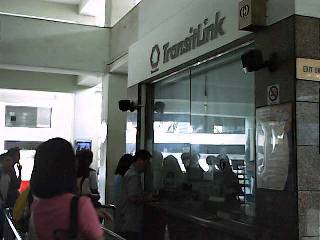
TransitLink counter at Boon Lay |
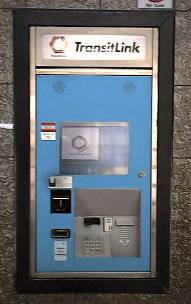
TransitLink automaton (farecard and NETS banking card required) |
Buses: Buses are somewhat primitive to handle, though much better than in the rest of south east asia. No signs telling you where you are or will be next, and some of the bus stops are not signed. The normal procedure when traveling by bus: Standing at the bus stop, extend your hand to signal the driver that you want to enter - otherwise he will just drive by.
Then, ask the bus driver "how much to <place> ?", which will (1)
confirm that this bus is going there (2) reveal which button you have to
press after inserting your card (blue side up, into the slot on the upper
right corner) in the automaton; your card will then come out of the lower
slot, together with your ticket. Anywhere in NTU to Boon Lay MRT is the
second button.
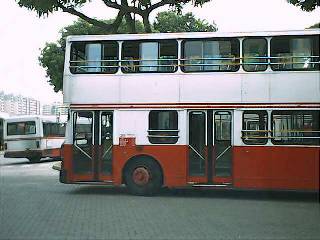
Standard non-aircon double decker Bus |
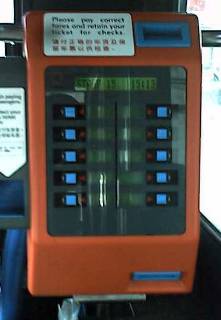
Bus Ticket Machine (insert your card blueside-up into the upper-right blue slot) |
Before paying, ask the driver to notify you when you arrive. They are fairly reliable, I never encountered any problem with this method. Prices differ for aircon and normal buses, by the way. And in the Popular Bookstore (which is everywhere) you can get a bus guide for 1.5 S$, which is really worth it. You can also try checking the SBS (singapore bus service) website, but this sometimes fails.
MRT: Meaning Mass Rapid Transport,
the MRT is exactly
that. Famous and good. Insert your card color-up in the front slot when
entering and again when leaving - this way, the system automatically extracts
the correct amount from your card. Your card will come out of a slot on
the upper side; a small green display shows you the amount left on your
card. No ticket is given, as the system calculates the amount for you.
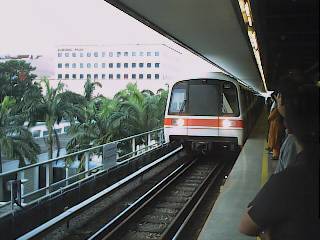
MRT arriving at Boon Lay platform |
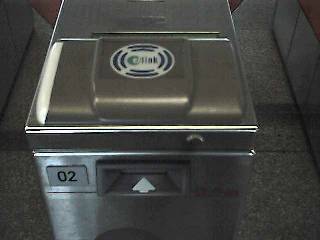
MRT Ticket Machine (insert your card colorside-up into the front slot) |
Once inside, a voice is announcing every station. The singaporeans are sometimes quite uncivilized when entering the MRT ("hushing and pushing wins the race" - kiasu!), but you get used to it.
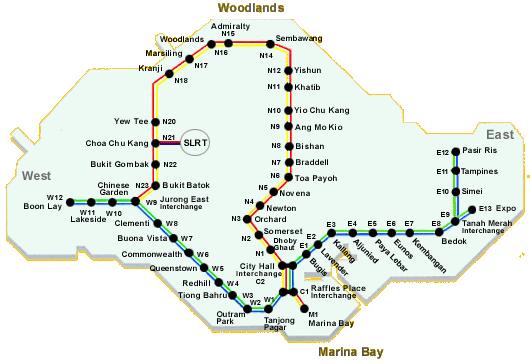
MRT map
The MRT system consists of two lines (east-west and north-south line). Both are driving in both directions. A way between two stops takes usually around 3 to 5 minutes. You can change the lines at the interchanges (Jurong East, Raffles Place and City Hall) just by walking over to the next platform.
Taxi: Quite inexpensive when going in a group. All taxis are metered and fraud is virtually unknown. Flag fare is around 3 S$; between 2400h and 0600h the prices are 50% higher. Popular taxi services include City Cab (phone: 5524711) and City Link (phone: 5522828).
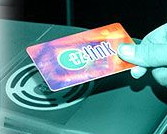
ez-link card used for MRT
Restrictions are: Never carry two of them with you. But sounds like a convenient thing anyway. I wonder what life with them would be if singapore had a hacking scene...
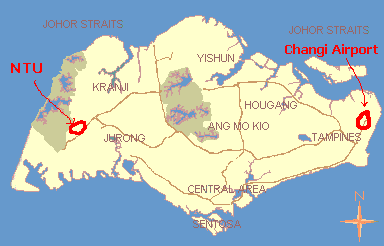
NTU vs. Changi Airport location
(see also Yunnan
Garden Campus Map)
A taxi to anywhere in the city (including NTU) should cost you about 25 S$, with 50% plus if you drive during nighttime (2400h to 0600h or so, I am not too sure about that). For 35 S$, you can get a limousine, but the 50% rule still applies.
If you want the heavy walk (not recommended if you are not used to tropical conditions), take bus 34 from Terminal 1 or 2 to Bedok MRT (or Tanah Merah MRT, one stop before Bedok), drive to Boon Lay MRT (the most western station) and take bus 179 (NTU) or 199 (NIE) to campus.
To come there, take the MRT to Lavender. Coming out of it (there should be a SIR sign telling you the direction), you are already there. No sweat. I recommend doing a bit sightseing in Bugis Village and Little India the same day; its a long way, after all.
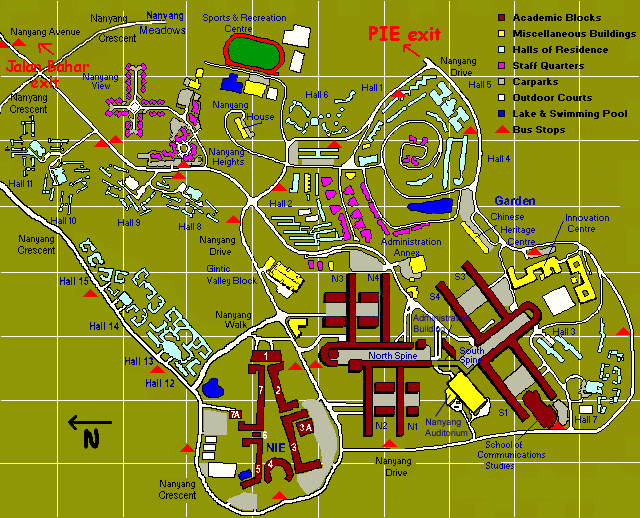
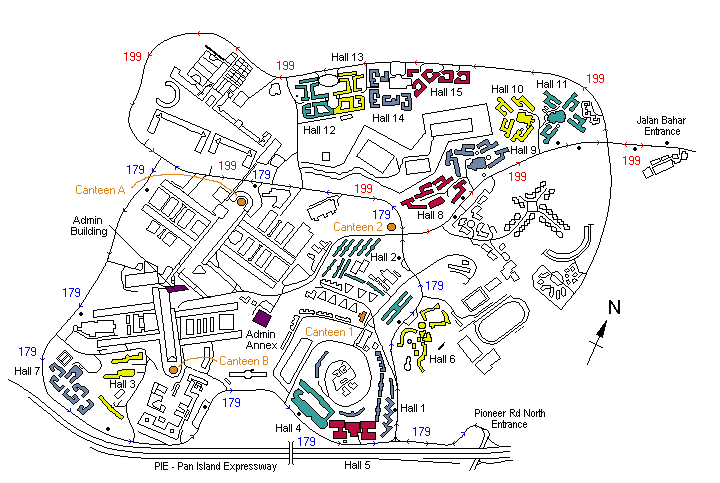
NTU campus map with halls and bus line 179 and 199
(arrows and labels are random; does not indicate bus stops)
You will be assigned to a random room in a random hall; however if you
object, you can make a request for moving (for me, it worked). Check carefully
whether you can come along with your roommate; I was always lucky, but
I heard this can be a major problem.
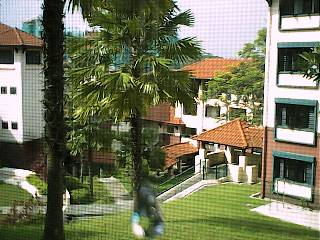
A look out of my window in Hall 10 |
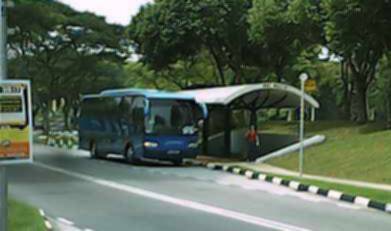
Bus stop just outside Canteen 11 |
Note for hall 8-11 complex (I was living in hall 10): There is no shortcut between the hall 12-15 and the hall 8-11 complexes - you gotta walk the whole way round. Forget about climbing the hill/water reservoir between them. I tried it, to no avail. The halls are quite nice, too. Not so nice are hall 7, 3, 4, 5, 1 (from left to right), at least when you are living in a block near the PIE (I was in hall 1 directly on the corner).
The Student Affairs Office (SAO) has a list of halls.
Canteen A is at the end of the North Spine, near the Library, and serves good indian and excellent japanese food. Canteen B is at the end of the South Spine, near the Medical Centre, and has excellent vegetarian food. Canteen 1 is at the crossing at the northern end of hall 1, and the chinese food and the chicken rice is good; the desserts are better than in any other canteen. Canteen 2 is near Canteen 1, at the bus stop near the NTUC shop, a popular place to meet with other exchangers; the Bat Ku Teh and vegetarian food are quite good. On a side note, Canteen 5 (near the PIE exit, inside hall 5) has excellent vietnamese noodles although its not very filling.
A word on the desserts: Most exchange students consider them all "odd" or "strange" or "disgusting" and never try them. True, they look awful, and some of them taste the same. But keep trying and you will be rewarded: For me, it was Strawberry De Longan, Chendol (both canteen 1) and Yam Paste (Lau Pa Sat, somewhere in the city centre).
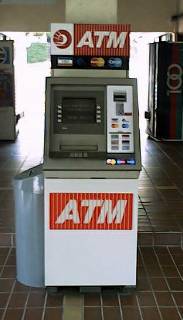
ATM Machine at Canteen 2 (cash and CashCard (student matric card) reload) |
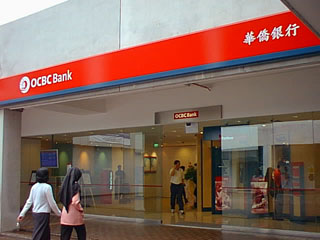
OCBC Bank, NTU branch (see also retailer list) |
Rules and Regulations: The account is free for students. Overdrawing is not allowed. If your balance drops below 500 S$, they will charge you 10 S$ per month.
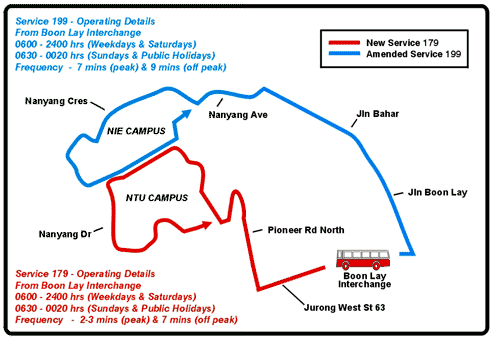
Bus routes around NTU
(see also Yunnan
Garden Campus Map)
If you are living in Hall 1 to 7, Bus 179 will probably be more suitable for you; for Hall 8 to 15, Bus 199.
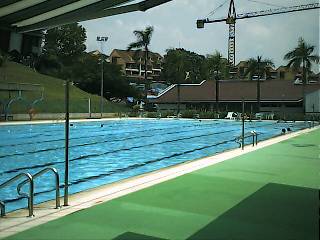
The NTU Pool |
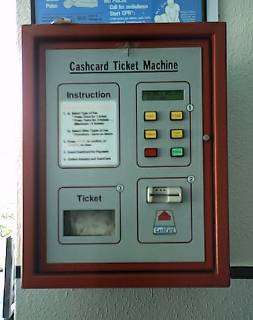
NTU Pool, Ticket Machine (pay with your student matric card) |
It is in the backyard of Hall 6, just down the hill from Canteen 2. Any person on your way is likely to know it (either as "swimming pool" or "SRC" (sports & recreation centre)), so just ask around.
The entry is 0.62 S$ for exchangers (I know - who invented that stupid price?). Payment is only possible per CashCard on their automaton. Fortunately, your student matric card is one. You can reload them at any ATM machine (choose "other options" when asked how much you want to withdraw). The nearest ATM is at Canteen 2.
Training is divided in 3-month sections (24 units of training), the
first one muaythai fitness; form, fighting and muay aerobic may follow.
Training is either monday and thursday, or tuesday and friday. Sessions
for beginners are one hour, 1700h, 1800h, 1900h or 2000h starting, although
in practice only the 2000h to 2100h lesson is reliable to be started. Just
drop by any weekday (except wednesday) at 2000h and try a session. One
unit costs 10 S$ (so the first 24 units 240 S$); students may pay on a
per-month basis (80 S$ per month). A few trial lessons are free, of course.
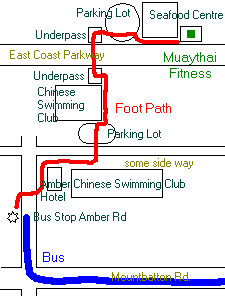
Last Steps until Muaythai Fitness |
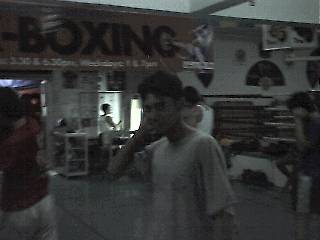
Inside the Muaythai Club |
To come there, take the MRT to Payar Lebar MRT, walk to the nearest bus stop (do not cross the street) and take either Bus 135 or 76 to Amber Rd. To come back, either take Bus 135 or 76 again to Payar Lebar MRT or Bus 36 to City Hall MRT (there is a Starbucks, great after training); be sure to take the bus stop on the opposite side of the one where you arrived at Amber Rd. Total time needed from NTU is about 1.5 to 2 hours, but if you are savvy for it... Take a friend or a good book with you.
Upon Amber Rd, cross the street, walk in the direction the bus was driving, and turn right at the Seaview Hotel or so. After 150m, turn left into the parking lot of the Chinese Swimming Club. Walk along its fence and you should come to an underpass of the east coast parkway. Turn right when you come up the stairs and walk along the east coast parkway (never mind the cars). Its 30m to go maybe to the entrance. Btw, if you walk straight instead of right, you come to the east coast beach after 100m. Pretty nice but the ocean tankers somehow spoil the view.
Training: You will sweat like a pig. Bring water. If you experience blisters on your feet, make a point of nivea-ing them before training. Other stuff to bring: A towel and showergel. A (very basic) shower is available. The trainers dont object if you come earlier or stay later to do your own training; time to try everything out.
The night zoo is an absolute must see. Although quite expensive (20-30 S$), just do it. I prefer to first take the ride, then walk by foot. You will, however, likely not see any free flying animals; although quite quiet, the visitors are still too noisy. My favourite is the big cage with flying foxes and bats which you can enter. The day zoo is also quite impressive, but after the night zoo not a must see. The polar bears and the butterfly cage are still big attractions.
The bird park is only for fans. Although hosting quite a number of impressive birds, I didnt enjoy it too much - it's just birds everywhere, and I am no ornithologican so I lack innate interest. One exception applies: The penguin area (air-conditioned, with lots of water) is far more impressive than its counterpart in the Singapore Zoo. Since I am a water fan, I spent most of the time here (the fact that it was some time raining outside may also have influenced me).
The reptile park is just on the other side of the parking lot. I have not been there yet. Still, after the crocodiles (very impressive) and snakes (still cool) and other reptiles in the Singapore Zoo I feel less motivation to go there.
As an overall recommendation: Rather go to the Singapore Zoo, even if its more expensive. The day zoo is much more clever designed, has far more to show in terms of variety and has a number of real cool animals.
The science centre is not something thats specifically Singapore, but its still lots of fun. In the mechanical/aviation/children area they have lots of cutie toys, it is really cool. The biology and math section is some cages, much text, and some computers, this was not of much interest to me.
The OmniMax theatre is well worth its buck (good 3D effects, especially when flying over a valley), but do not go into the Virtual Voyages theatre (its a shitty small cinema with a minimally rumbling seat arrangement - 2 year olds would have their fun).
Far smaller than expected, the Tiger Balm Gardes are still quite cool (you are not allowed to enter Haw Par Villa). The area was founded by the brothers that invented the famous Tiger Balm. All the different sceneries displayed are made of colorfully painted concrete. They tell of a lot of chinese mythology, which I found quite interesting.
Its a hilly area, so dont come on a really sunny day.
Officially titled "Chinese and Japanese Gardens", only the chinese part is worth visiting, with nice bonsai trees, a few buildings and decent garden architecture. The japanese part is decidedly run down and I could not detect anything of japanese style there, a real disappointment. I wonder if that has something to do with war ressentiments against the japanese.
Coming there, you will get a lot of information stuff anyway, so no need to fuzz around. The beaches are quite nice (although the ocean tankers, once again, spoil the view, and the water) and the Underwater World (which is, unfortunately, inseparably combined with the dolphin show, and thus with 17 S$ somewhat expensive for a single attraction) is really cool. The rest of the attractions where I have been didnt impress me much.
All in all, plan 100-150 S$ for the day you are going to sentosa, and you will get along quite good.
The bus stop next to the club said buses 85 and 195 are stopping by. I recommend a taxi and coming per group.
The club is on the far east plaza (take a cab). The Lau Pa Sat (famous food centre) is quite nearby, ideal for snacking in the morning.
"There is also the foam party on Sentosa. It's once every month or something like that [black moon], but you have to look up when. Maybe it's the first Saturday or something. (My skin is still peeling of since the last one, cause the foam obviously kills at least one or two layers of skin... :)"
"Tiger Village, if there is something called TV which I'm not quite sure of, is the place nearest to NTU where you can get a decent beer combined with something to eat. Either at McD or something local. Just follow bus 177 out from campus and it's one or two stops away. Don't bother taking the bus. Walk." [no decent links found]
"People are probably planning to go travelling and perhaps diving when they go to Asia. Join the NTU diving club and get a license during the recess week. It's cheep (350S$) and includes theory, practicing in a pool in Singapore, trip to Pulau Aur in Malaysia including food and the stay there for a couple of days. It's an easy and fun way to get PADI-certified. The bottom is the limit."
/Magnus (Magnus Berger)
Stuff everything into plastic bags. This will keep your stuff dry and clean, especially if a bottle is leaking (happened to me once). The rustling will also make such a noise that no thief on earth can think about stealing your traveler cheques if they are deep within the rucksack.
Malaysia will be your most frequent visit, I suppose. To get a first taste, take the MRT to Kranji, cross the bridge above the street and get into Bus 170. It will stop at the border; keep your ticket. Singapore customs will be quite speedy with your students visa. Upon exiting, get into the 170 queue and use the same ticket instead of drawing a new one (show to the driver; they are used to this). On you go for Malaysia customs, where you have to fill out some paper. Memorize your passport data and dont forget to bring a pen. After that, you are in Johor Bahru.
Upon returning (by bus or by train, the latter one stops directly at Singapore customs), you can either take Bus 170 again or, across one bridge and one road and a little bit to the right, Bus 911 or 912 to Woodlands MRT (those will be less crowded).
Places very worth visiting in Peninsular Malaysia are KL (Kuala Lumpur), Taman Negara National Park, the Sekayu Waterfalls and Perhentian Islands (preferably Long Beach). Still worth visiting are Tioman Island, Cherating (both nice beaches) and Kuala Terenganu (only for getting a glimpse of muslim malay life). Definitely not worth visiting are Kota Bahru and Kuantan on the east coast. About Melacca and Penang, I dont know.
The night trains are bliss compared to the buses, although slightly more expensive. They go once per day (in the evening) and are often booked out, so book in advance. Buses are always available to everywhere.
I have been on Ko Samui, Ko Phangan (the infamous full moon party, which is really good (techno)) and Bangkok. I heard Ko Phiphi and Krabi are also nice, and Chiang Mai (in the north) should be culturally interesting.
For Ko Phangan, take a bus to Surat Thani and get a night ferry over there. In Thailand, you can always buy tickets at the pier, regardless of what the touts are saying. They are trying everything to sell to you. On the island, rent a motorbike (150B = 3.5 US$ per day) and find a decent place. While Ko Phangan is advanced terrain (very mountainous), Ko Samui is supereasy going in terms of driving.
Upon returning to Surat Thani (by nightferry, I suppose; sleep until 0700h, you need the sleep), try a Songthaew (pickup with 2 benches, standard transport) to bring you to the government bus terminal for 10B. Probably the guy will suddenly stop speaking english when bringing you to the VIP bus terminal. If so, exit to the main street and take a normal bus to the terminal. A bus goes to Bangkok at 0845h, costs 380B and is heaven on earth; I have never in my life had so much legspace, there was a (clean) toilet, occasionally drinks for free and movies (in thai language, but still interesting).
In Bangkok, have phun. Bus 15 goes to the Khaosan (Banglampoo) area. Get yourself a tourist map (free) and a bus map (40B). For returning, Bus 53 goes to the train station. Bus 3 goes to the Chatuchak weekend market.
From Bangkok, every travel agency sells dirt cheap (150B) bus rides to Siem Reap (Angkor) in Cambodia. Try to get one with return, as in Angkor same return will cost 15 US$ (= 660B). Or you can go by pickup truck (3 US$) plus train (50B) back, but the pickup ride, though fun, will leave you looking like a neandertal.
In Siem Reap, hire a motorbike with driver for 5 instead of 6 US$ per day and haggle a bit about room prices (staying several days instead of one is the usual argument used). Take the sunrise at Angkor Wat every day if possible, it is just beautiful. Do not let the drivers take the planning, as most guide books know better than them.
Try lots of cambodian food. It is more natural than Thai food and tastes great; around Angkor you should have no problems with hygiene as this is major tourist area.
EOF (Nov:2001)